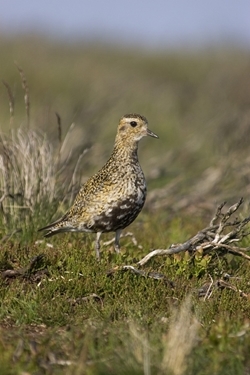Golden plover
 Way back in November 1951, the managing director of Guinness breweries, Sir Hugh Beaver, was shooting with friends in the county of Wexford in Ireland. After missing a shot at a golden plover (Pluvialis apricaria), he became involved in an argument over which was the fastest gamebird in the British Isles. The assembled shooting party thought it was either the golden plover or the red grouse, but having looked through numerous reference books, Sir Hugh could not find an answer.
Way back in November 1951, the managing director of Guinness breweries, Sir Hugh Beaver, was shooting with friends in the county of Wexford in Ireland. After missing a shot at a golden plover (Pluvialis apricaria), he became involved in an argument over which was the fastest gamebird in the British Isles. The assembled shooting party thought it was either the golden plover or the red grouse, but having looked through numerous reference books, Sir Hugh could not find an answer.
Sir Hugh realised that a book supplying the answers to this sort of question might prove popular and so he made contact with twin brothers, Norris and Ross McWhirter, who had opened a fact-checking agency in London. Sir Hugh interviewed the brothers and, impressed by their prodigious knowledge, commissioned just such a book.
As a result, the first Guinness Book of Records was published in 1955 and, as we all know, went on to become a huge success and worldwide bestseller. Incidentally, the golden plover can fly at around 60 miles per hour and is considered faster than the grouse!
In the summer, an adult golden plover is a handsome bird indeed, having a black throat, chest and belly, surrounded by a band of white, all topped off with a vibrant gold and black spotted back and cap. In the winter months they lose the black, which is replaced by buff and white, and generally the plumage becomes less spectacular.
Large numbers of golden plover breed in Iceland (where their arrival is greeted as a sure sign that spring has arrived), while others choose Scandinavia as well as central Siberia. In Britain, around 49,000 pairs choose to breed in upland areas, in particular in the northwest of the country.
GWCT research has shown that the breeding success of curlew, golden plover and lapwing was significantly improved by controlling the numbers of some of their predators, such as carrion crow and fox. They were more than three times as likely to raise a chick on an area with predator control than on an area without.
During the winter months, large numbers (400,000 individuals were counted in a 2006/07 winter survey) over-winter around our coasts, where they mix in with wader flocks, and they also frequent lowland farmland where they often mix in with lapwing flocks. Sometimes, especially on arable ground, they can be extremely well camouflaged against the soil, so that a casual glance might well result in only lapwing being noted in the observation notebook!
As with others in the plover family, they typically stand upright and run in short bursts, before stopping to look for worms or insects. If the mixed flock takes to the wing, then they immediately show how different they are from the rather laboured, bouncy flight of the lapwing, by forming a tight formation with rapid wingbeats, twisting and turning as they go.
On coastal mudflats, they can be distinguished from their close cousins the grey plover in flight by their white ‘armpits’, whereas the grey plover has black ‘armpits’.
So, see if you can find these beautiful plovers this winter, especially when you are out and about in “open country with big skies”, as they favour this type of habitat. Also keep an ear cocked for their rather plaintive, often repeated flight call, as this can often be the first indication that they are about!
Photo credit: David Mason

Download Peter Thompson's essential 26-page book, featuring beautiful photography and detailed profiles of Britain's wildlife
Download FREE >